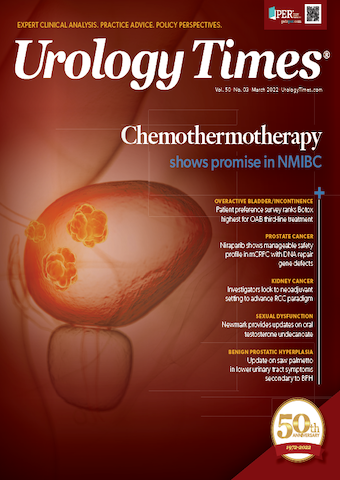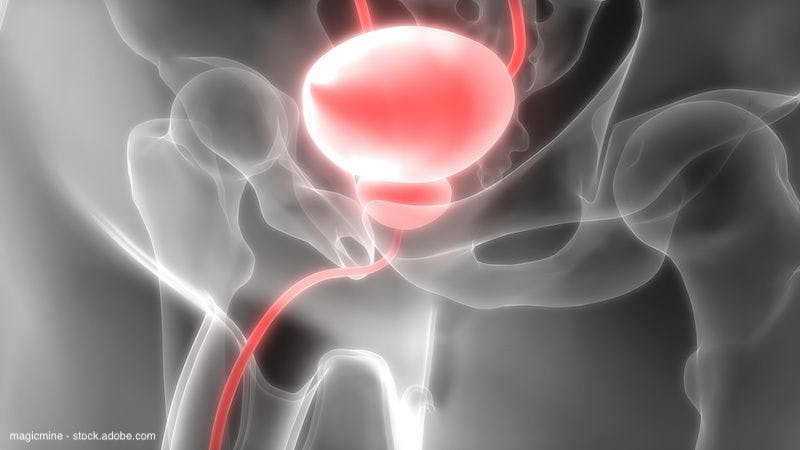Publication
Article
Urology Times Journal
Chemothermotherapy shows promise in non–muscle-invasive bladder cancer
Author(s):
In this interview, Brant A. Inman, MD, MS, FRCSC, discusses how investigational chemothermotherapy could mitigate some challenges presented by current NMIBC treatments.
Brant A. Inman, MD, MS, FRCSC

Non–muscle-invasive bladder cancer (NMIBC) can be treated with BCG or intravesical chemotherapy; however, supply shortages continue to plague BCG, and intravesical chemotherapy is not always efficacious in patients.
In this interview, Brant A. Inman, MD, MS, FRCSC, discusses how investigational chemothermotherapy could mitigate some challenges presented by current NMIBC treatments. Inman is a professor of urologic oncology and codirector of Duke Prostate and Urologic Cancer at Duke University in Durham, North Carolina.
Could you explain the rationale for chemothermotherapy versus intravesical chemotherapy alone?
Inman: I think for many years now, people have recognized that intravesical chemotherapy is not always ideal. [Many patients] have recurrences of bladder cancer or, worse yet, [cancer progression], despite what would appear to be adequate intravesical therapy. The question is: Why is that intravesical chemotherapy not working?
[Many reasons] could potentially exist for this. One would be that the drug is not penetrating adequately into the wall of the bladder. Another might be that the cancer cells in the bladder are resistant to the particular drug being used. Perhaps there are alternative reasons too; it’s possible that the cancer is adapting over time, and a cell that was once sensitive is no longer sensitive. Therefore, there are a variety of potential reasons why we might see intravesical chemotherapy as being less than optimal.
The idea of heat—in combination with intravesical chemotherapy—is to address that problem. Heat makes cancer cells more sensitive to certain types of chemotherapy. For example, if you take a cancer cell at body temperature, which is 37 °C, and you expose it to a chemo drug, you will observe a certain drug kill rate. You can take that same cell and expose it to that same chemotherapy drug, but this time at 43 °C, and it turns out that, for many drugs, they work much better. Something about the heating of cancer cells, in many circumstances, will make them more sensitive to certain chemotherapy agents. It’s not all chemotherapies, but a subset of all chemotherapies.
One other thing is that when we warm the bladder by heating its contents, it makes the bladder more permeable to drugs, including chemotherapy drugs, so there’s an improvement in drug delivery.
The last thing we know happens when we heat cancers is that changes occur in the immune response or in the local immune microenvironment surrounding the cancer cell. This also could lead to some changes in how well the treatment works because we may be bringing on a new mechanism.
One thing I also want to just briefly mention is when I’m talking about heating here, I’m talking about heating in what we call the “fever range.” Fever-range hyperthermia is heat somewhere in the 41 °C to 44 °C range, typically 43 °C. Anything above 45 °C, it starts to feel painful because it’s getting pretty hot. When we heat enough to destroy tissues, like if I [were] to toss you in a fire—and we’re talking about temperatures above 60 °C—then we are doing ablative hyperthermia. For bladder cancer, I am not talking about ablation. Rather, [I am] talking about fever-range heating.
What special equipment is needed to do this?
You need a bladder heater. There are several alternatives available for this right now, some of which are really expensive and difficult to operate and some of which are simpler.
The first devices...used were extravesical bladder heaters. Imagine a large device that requires a special room to put it in. And you lie on a table, and then balloons of water basically push against your belly. Through these balloons...radiofrequency rays [focus on] the bladder; that radiofrequency radiation causes the bladder to heat up. And you can heat basically any intra-abdominal or pelvic organ in this way. These are big machines and very expensive, costing typically hundreds of thousands of dollars. There are several manufacturers of these kinds of machines out there, and the Pyrexar [Medical] BSD-2000 is one example. The major disadvantage, of course, is the cost. Additionally, you require a medical physicist to run it. It’s just very challenging. We’ve done clinical trials at Duke using this kind of device. It works; it’s just not ideal.
Other devices are simpler. For example, there’s a device called the Synergo, which is an intravesical catheter that has an antenna on its tip that emits radiofrequency. So instead of projecting radiofrequency waves through the body and focusing them on the bladder, this is a catheter that emits radiofrequency waves from within the bladder, and that serves as the heater. The advantage...is that it’s manageable with a special Foley catheter, and there’s no external device. You don’t need a physicist to operate it. The disadvantage is that there can be hot spots because the catheter doesn’t transmit heat uniformly. The device does require fairly constant nursing monitoring, which means that it’s not easy to leave the room and treat the patient. It’s also a fairly expensive device.
The more recent bladder heaters, the ones that we’ve been using at Duke more recently, are intravesical recirculating heaters. These work by having a catheter in the bladder that circulates the fluid within the bladder. That fluid is heated outside the body and then reinfused as a warm fluid. This is, for example, how intravenous [IV] fluid warmers work. If you have an IV fluid, we don’t usually want to pump it into you cold, so the fluid is warmed to body temperature as it’s infusing. The device that we’ve been using is the Combat BRS [combined antineoplastic bladder recirculation system], which is probably the most commonly used kind of recirculating or convective bladder heater. The advantage of these is that they’re much smaller and simpler devices. They’re also substantially cheaper, easier to run, and they don’t require careful monitoring for burns and things like that because the fluid is heated very accurately.
Which chemotherapy or combinations hold the most promise with this type of therapy?
Right now, the majority of clinical trials have been done using mitomycin C. The reason for this is mitomycin C is one of the chemotherapy drugs that has been shown to be significantly impacted by heat. Its efficacy is higher with heat.
That being said, [new clinical trials are] about to start that will be assessing other agents such as gemcitabine, which is one of the more common intravesical agents that we use now. I’m unaware of any other human trials that have tested other drugs. [It is important to] note that even if a cancer cell is not more sensitive to a particular drug when it is warmed, bladder heating might improve drug delivery or add an immune response that could improve overall treatment efficacy.
An interesting consideration is the use of systemic chemotherapy drugs that are packaged in heat-sensitive liposomes in combination with bladder heating. Several drugs exist in heat-sensitive liposomes such as doxorubicin, cisplatin, and gemcitabine. Using the Combat BRS bladder heater, we could deliver drugs systemically (intravenously) to the bladder and achieve much higher tissue doses while minimizing systemic toxicity. This has been tested by our team at Duke in a large series of pigs.
In what risk groups do you see this as being the most beneficial?
We don’t know the answer to that yet. What we do know is that if intravesical therapy can be improved—either by making the drug delivery better, [by] making the cancer cell more sensitive to the drug you are giving, or by adding an immune response—then theoretically, it could be any stage of disease that we would use intravesical therapy and that could be improved by adding heat. [This] is the question that’s currently being asked by a number of clinical trials out there, both in intermediate-risk and high-risk non–muscle-invasive bladder cancer.
For muscle-invasive bladder cancer, heat has been added to radiation therapy on trial. Additionally, as I mentioned previously, heat can be used in conjunction with systemic chemotherapy to improve drug delivery to the bladder. It could be possible to eradicate more muscle-invasive bladder tumors if we just get better chemotherapy delivery.
What do the data show in terms of the efficacy of this treatment?
Of the clinical trials that are already available, it seems that a couple of patterns have emerged. First, heated chemotherapy seems to be better than room-temperature chemotherapy, at least for mitomycin C. Second is that heated chemotherapy was shown to be similar to BCG in terms of efficacy in one randomized clinical trial. That has not been replicated because the trial is relatively new. But it also brings up the question of...if we combine chemotherapy with heat, can we achieve an efficacy similar to that of BCG?
Right now, BCG is the best agent for high-risk non–muscle-invasive bladder cancer, but it has suffered from a number of problems, including a lack of availability. Lately, [worldwide drug shortages] make BCG treatment very, very challenging for many physicians and patients. Even if heated intravesical chemotherapy is a treatment that is no better than BCG, it may be a reasonable alternative to BCG because it’s more available and manufacturing is more reliable than BCG.
How well tolerated is chemothermotherapy? What adverse events have you seen?
The [adverse] effect profile appears very similar to other intravesical therapies. The main things are urgency and frequency of urination, irritation in the bladder during treatment, and urinary tract infections [that are] probably associated with the catheterization more than the device itself. Those are the main things, so it seems to be very well tolerated.
One thing we did notice at Duke when we were using higher-dose intravesical chemotherapy, in particular higher-dose mitomycin in combination with heating, is an increased incidence of drug-sensitivity reactions. The patients seemed to have a higher rate than we would usually observe of allergy-type reactions to mitomycin, including skin rashes and such. Others have not confirmed this yet because we’re the only group that has used higher mitomycin C doses. I’m not sure if that’s unique to our center or not.
My understanding is that you’ve been able to make this available to select patients in the US through a special arrangement. Could you discuss this and also what you’ve personally experienced and learned in using this therapy so far?
Because of the worldwide drug shortage in BCG, we were looking for options at Duke to treat patients with high-risk non–muscle-invasive bladder cancer or patients in whom BCG has previously failed and [patients] we couldn’t give BCG because it just wasn’t available. Our options were to use standard intravesical chemotherapy, which historically has not done that well, or to remove someone’s bladder surgically. Many patients are not ready to go to that step, so we were looking for an alternative.
Given initial promising results in Europe, I applied to the FDA for a humanitarian-use exemption to utilize the Combat BRS bladder heater that is available in Europe but not in the United States to administer chemotherapy agents. They approved me to use this device with mitomycin C. We treated a number of patients with the Combat BRS device and mitomycin C at higher doses. We found it to be pretty efficacious, and we recently published our data on this. That study is not really a clinical trial, per se; it’s a humanitarian exemption protocol that allows us to use it during the worldwide drug shortage. So it’s a way of, we hope, improving the efficacy of existing agents when the standard of care is not available.
Do you see this coming to North America anytime soon?
The answer to that will depend on the results of several clinical trials that have been completed and are currently going to be reported in the next year or two. For the FDA to approve this device and make it available, there has to be evidence that it has benefit. [A] number of clinical trials that have been done or that are currently enrolling in Europe and elsewhere...are going to answer that question. I suspect that if the data look favorable on these clinical trials, a package will be presented to the FDA to seek device approval for the United States.
Any final thoughts on this technology and how it could contribute to the bladder cancer armamentarium?
That’s a good question. I personally am not married to any particular technology. I’m not sure whether heat alone or other new technologies are ultimately going to be the standard of care or not. But I do think that we need to improve on what we have right now. [For] patients in whom BCG doesn’t work, we’re using chemotherapy drugs, typically as monotherapies and more recently as combinations. My hope is that by improving the way we administer these drugs, maybe we can make them work better. Maybe by improving the combinations of drugs, we can make them work better.
It’s my hope that eventually we’ll find a cocktail that beats BCG, stops these tumors from coming back, [and] stops these tumors from getting worse so that patients with non–muscle-invasive bladder cancer aren’t faced with the need to make a decision to have their bladder removed or not.

































